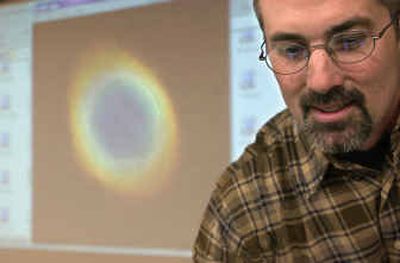Science students look to the stars

Amanda Wing looks into the nighttime sky and imagines what civilizations live beyond our universe.
“I’ve always been enchanted by the stars,” said the Coeur d’Alene High School junior.
Thanks to a grant from the EXCEL Foundation, her high school astronomy class now has a $1,000 light projector that lets Wing tap into the enormity of the heavens. EXCEL is the nonprofit organization responsible for the “No Moose Left Behind” public art project last year.
The galaxy awaits as students tell science teacher Tim Burnside which scenes from the cosmos they’d like to see. Images are transposed from a television monitor to a large screen with the aid of the new projector. A globular cluster flashes in front of the classroom and a student responds with, “So cool.” Burnside tells the students that light from this dense collection of stars will take millions of years to reach Earth. More “oohs” and “ahs” are heard when a swirling galaxy shows up in spirals of purple and pink.
One of Burnside’s students said he’d like to work for NASA, while another is contemplating astrophysics. Some have no interest in a science career, but enjoy recognizing the brilliant lights in the sky.
The students speak proficiently about light years, latitudes and nebulas. Their lingo was acquired through the classroom textbook, “The Complete Idiot’s Guide to Astronomy,” which Burnside chose for its easy reading style and small size. He thought that kids had enough heavy books to carry around.
Burnside pitched his idea for the elective class to the school board and got the green light to begin last fall. A mixed-grade group of about 15 high school students are enrolled in one class, which Burnside fits in between required physical science courses. Students are already asking if there is an Astronomy II and he would love for the program to grow.
“I would hope they leave with a greater interest in astronomy and know that learning doesn’t stop when the last bell of the day rings,” Burnside said.
Stars emerge at night, which is a challenge for a classroom that runs on a daytime schedule. Burnside solves that by requiring several “star labs.” Night viewing takes place on the Rathdrum Prairie where students learn that “good seeing” means good conditions for star-gazing. Burnside is well-acquainted with the area. He grew up in Post Falls and taught at Lakeland High School for 10 years before joining Coeur d’Alene High School three years ago. He said that astronomy and cosmology were his favorite courses when he was at the University of Idaho.
The prairie is not ideal, but it’s too difficult to take the class farther away from city lights and still be home by 10 p.m., Burnside said. Students can still see a quite a bit with a telescope. Burnside brings his own from home and sophomore Kyle Lantzy brings another. Lantzy’s enthusiasm was invaluable to Burnside last fall, so he was recruited as a teaching assistant for the second semester class. He assembled the class’s new $650 Orion Intelliscope, which was recently purchased with science funds. The 8-inch reflector allows for detailed viewing and the equipment’s “brain” calculates positions to locate tiny specks in the sky.
Students are learning how to use the equipment, create models of the Hubble Space Telescope and name the craters on the moon. Each semester, Burnside has students create a PowerPoint presentation that focuses on a constellation of their choosing.
Wing chose to study Perseus and learned about its mythology along the way. She has had her eye on the stars since childhood, when her parents bought her a telescope. The class has “completely skyrocketed my interest,” she said.
Wing is considering putting aside plans to become a chemical engineer and seeking a career in astronomy instead.
“It’s very possibly what I’m going to do for the rest of my life,” she said.
That would suit Burnside just fine. He tells his students that many stars are named after amateurs who discover them from their back yards.
“I’m hoping one of these guys will attach their name to a comet someday,” he said. “That would make me proud.”